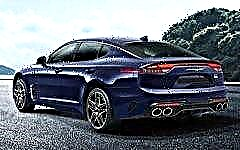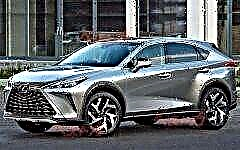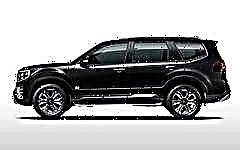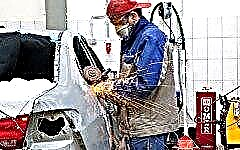

The content of the article:
- Varieties and causes of damage
- Classification
- Restoration of paintwork equipment
- Bottom repair
- Removing dents
- Internal body cavities prevention and repair
- Major overhaul
- Paintless removal of dents
- Bumper repair
- Polishing and straightening
Timely body repair and painting of the car significantly increase the service life of the vehicle. The car owner must periodically make not only an external inspection of the car, but also look into more inaccessible places - under the bottom and the hood, since the body is an important and expensive element of the car.
Finding a problem quickly affects both the speed of its implementation and significant savings in money. The slightest scratch or harmless chip makes the body metal defenseless against corrosion, which can destroy the integrity of the surface for a year.
Varieties and causes of car damage

Fault categories:
- mechanical;
- corrosive;
- destruction of the anti-corrosion surface.
Mechanical damage occurs as a result of accidents and driving on country roads. The complexity of the repair depends on the degree of the received malfunctions. Of course, if the vehicle is not easier to sell for parts.
As a result of car accidents, the geometric parameters of the car are violated, which are returned to the original factory state by service stations, service centers and auto repair shops. Moreover, damaged elements can be replaced if they cannot be restored.
Classification of auto bodywork

The restoration of car body elements is divided into two main categories: local (minor) and complex (major).
There are also subcategories. For example, external repairs and works of medium complexity. The first involves the application of paint and varnish coatings (LCP) and the performance of airbrushing, and in the second case, restoration work with the possibility of replacing individual parts.
Body reconstruction cannot always be done by hand, since extensive damage requires diagnostics and specialized tools.
Types of body repair:
- Restoration of geometry. Returning the geometric parameters of the body to the factory ones. If necessary, parts are replaced using metal cutting and welding.
- Paintwork. Body painting is done after repair and processing.
- Selective (local) painting. Damaged or replaced parts are painted. At the same time, careful attention is paid to the shades of the paint, so that color imbalance does not arise.
- Abrasive polishing. It is used if the paintwork has damage in the form of shallow scratches and non-critical defects. Abrasive pastes of various grain sizes are used. Read the article - Do-it-yourself car polishing.
- Local anti-corrosion work. The affected parts are cleaned to the metal surface. For these purposes, rust converters are used.
- Alignment of dents without damaging the paintwork. Removal of problem areas is carried out using the Dellen ohne Lackieren technology, which does not require painting. Read the article - How to straighten a dent without painting.
- Front and rear bumper restoration.
- Restoring thresholds. The work involves the restoration of places for the jack.
- Tin work.
- Welding works.
- Work on the slipway. A device designed to restore the body shape after accidents.
- Straightening.
Specialized equipment and adherence to process technology are the main factors in performing high-quality body restoration work.
Restoration of paintwork equipment

In order to save time and money, non-critical damage to the surface of the vehicle body can be eliminated by hand. First of all, this is due to the prevention of corrosion.
Before starting work, you should stock up on the necessary materials:
- primer and paint;
- sandpaper;
- solvent;
- putty.
If the damage is fresh, it will be sufficient to clean it of dirt and dust, and then wipe it with a rag soaked in solvent. The dried surface is primed with a thin brush or foam sponge.
After the primer has dried, paint is applied - by spraying or with a brush. If the shade is correct, then the restored area will not stand out on the surface of the body.
If traces of corrosion appear, then sandpaper or sandblasting will be required. Cleaning the affected area should be carried out with the "capture" of the paintwork. Bare metal is treated with a solvent and a putty is used to level the work surface.
Puttying (if necessary) is carried out in several layers. In this case, each layer is sanded and degreased. The final step is to apply a primer and paint the surface.
Repair of the bottom of the car

Manufacturers treat most car undersides with special mastics that can fight corrosion for many years. The effectiveness of mastics is reduced to zero if the integrity of the protective layer is violated.
Driving on roads of poor quality (country roads, forest roads, with potholes on asphalt surfaces, etc.) leads to damage to the vehicle bottoms. In this case, it is necessary to timely protect the exposed metal, since under the influence of corrosion in the floor of the car, additional (unwanted) sources of ventilation will appear in a year.
Restoring the protective layer of the bottom of a car can be done by hand. This is a simple process, but inconvenient. Be sure to have eye protection - a mask or glasses.
Materials for repair work are:
- sandpaper;
- solvent;
- primer;
- bituminous mastic.
First, dirt and rust are removed from the damaged areas of the bottom. Then a solvent is applied to remove the remaining dirt. Problem areas are primed and, after drying, are treated with mastic.
Removing dents

When the dent has an open character (chips, delamination), then with the right approach, you can do without the help of professionals.
First you need to level the damaged surface. Using a suitable tool (screwdriver, pry bar, hammer handle), a metered force is applied to the inside of the body part. Rubber tips are used to avoid scratches.
Sanding, filling, priming and painting are performed after the work surface has been leveled as much as possible.
Internal body cavities - prevention and repair

A car frame is, first of all, a metal that can properly serve for more than a dozen years, but it is defenseless against corrosion. There are enough hard-to-reach places inside the car, but the following are considered the most vulnerable:
- niches for doors and trunk lids;
- thresholds;
- spars.
In preventive measures, anti-corrosion agents are used - "Movil" or the like. When using thick mastic, it is necessary to dilute it with a solvent. If cans with protective components are used, then it is enough to choose a suitable nozzle.
Anti-corrosion treatment is carried out without disassembling the body parts. For its exact implementation, it is necessary to refer to the vehicle maintenance manual, which usually contains a diagram for carrying out anti-corrosion work in hidden cavities and ways of accessing them.
Major overhaul

When the body structure is critically damaged or a complete replacement of parts is required, a major overhaul is performed. Similar procedures are required after car accidents or natural disasters.
At the same time, self-alignment of the body geometry and further repairs are impossible without specialized tools and suitable conditions. It is in such cases that an appeal to specialists is relevant.
Equipment required for body reconstruction in service centers:
- lift;
- slipway (used when restoring the geometric parameters of an automobile body using high-tech electronic measuring systems);
- welding machine;
- jack;
- spotter (for straightening);
- pneumatic tool;
- locksmith's tool;
- inventory for carrying out tin works.
Also used are racks, chains, grips, workbench, anvils and other means to carry out repair work.
Paintless repair of dents

This method of removing irregularities on the surface of body elements has now gained high popularity. Such methods are to the liking of any car owner, since during the operation of the vehicle, "offensive" defects often appear on the surface of body parts. Such damage can result from the intentional or unintentional impact of hands and feet, hail, unsuccessful parking and other factors.
The unpainted leveling significantly saves time for motorists. Financial savings are also evident, since there is no need to purchase various "cosmetic" products.
The main advantage of such a restoration is the high quality of the work performed.
The Soviet auto industry is not suitable for such repairs due to the soft body coating. It is better not to do such a restoration with your own hands, since it is almost impossible to get rid of dents without violating the paintwork without proper skill and the availability of the necessary tools.
Bumper repair

For convenience, the bumper is usually removed and the composition of the element is determined.
Work progress:
- irregularities are removed by heating;
- chipped scratches are putty and sanded;
- for faults, heat sealing is used;
- the product is painted using standard methods.
Polishing and straightening

There are two types of polishing - protective and abrasive. The first is to apply wax-containing components to the surface of the body, and the second is to apply abrasive pastes to the paintwork, previously cleaned from a thin layer of factory paint.
In both cases, polishing serves to eliminate minor scratches on the body elements and brings the car's appearance to the factory condition.
Straightening work consists in correcting damaged bodies. These include both the restoration of the geometry of the car, and the correction of dents and damage. The ultimate goal of straightening is to bring body parts to the state in which they were after stamping.
When carrying out straightening repairs, anvils of the appropriate configuration are used. Due to the change in the physical properties of the metal, when working with it, it is necessary to have not only special hammers, but also the correct "impact arrangement" - weak but frequent blows. If the working surface of the product has folds, then the restoration begins with them, with a movement towards the center of the defect. In this case, it is necessary to check the restored metal by touch after several blows in a row.
Conclusion
Vehicle body repair can be done by hand if:
- damage is not a critical level;
- the necessary inventory and means for recovery are present;
- the owner has the right skills.
When it comes to complex repairs or the car owner has excessive requirements, as well as in the absence of places for restoration (garage, adjoining territory, etc.), you should contact specialized repair centers.
Corrosion is the main enemy of a car and its owner. Rust can kill a car of any manufacturer. The first anti-corrosion treatment must be carried out in service centers. Moreover, in Russian conditions, this is mandatory even in cases where the car has just left the factory assembly line.
With the proper approach and careful attitude, the car can serve its owner for more than a dozen years.











